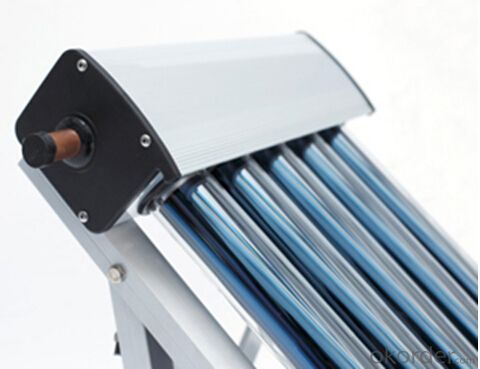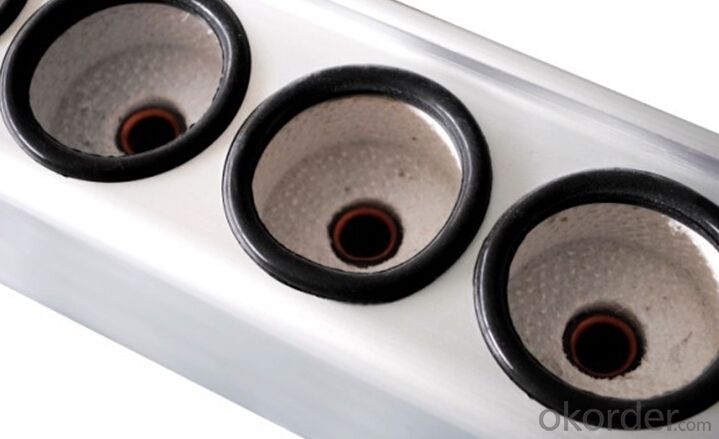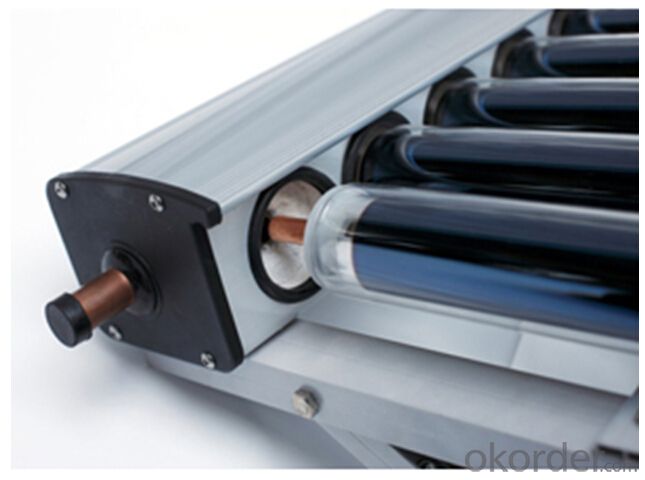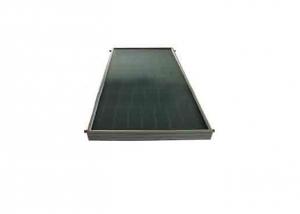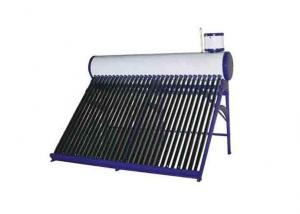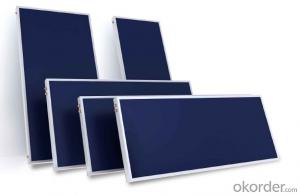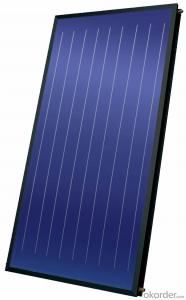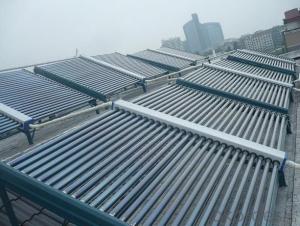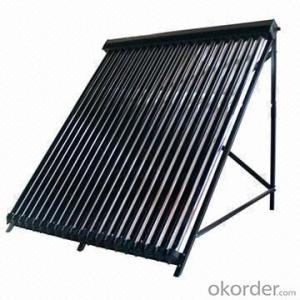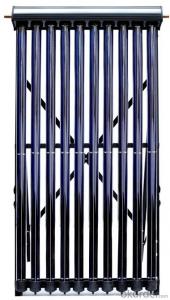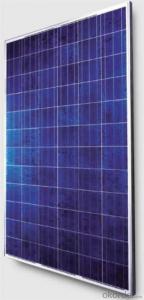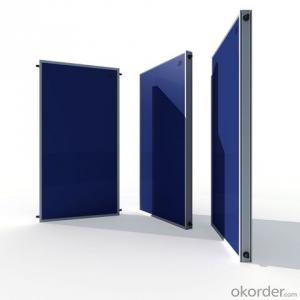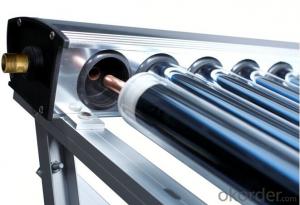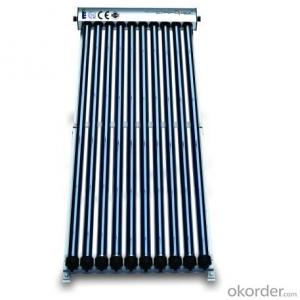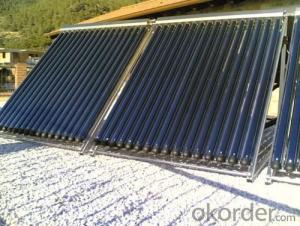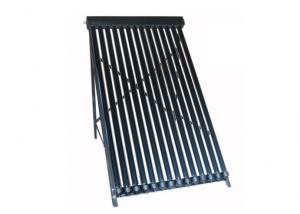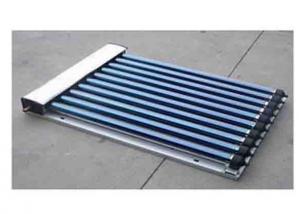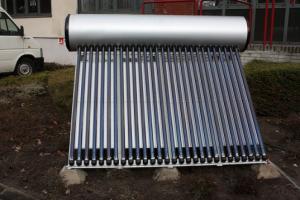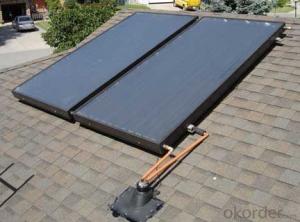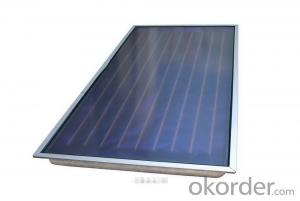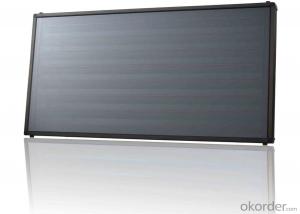Apricus Evacuated Tube Solar Collectors - Polyurethane Foaming Insulation Model SC-HP
- Loading Port:
- Shanghai
- Payment Terms:
- TT OR LC
- Min Order Qty:
- 50 set
- Supply Capability:
- 200 set/month
OKorder Service Pledge
OKorder Financial Service
You Might Also Like
1. Structure of Polyurethane Foaming Insulation Solar Collector Model SC-HP:
This product is composed of aluminium alloy for frame, polyurethane and aluminium silicate for the insulation,tri-element vacuum glass tube and antifreeze heat pipe. It can work under the environmental temperature from -40℃ to 95℃.The solar collector has the structure as follows:
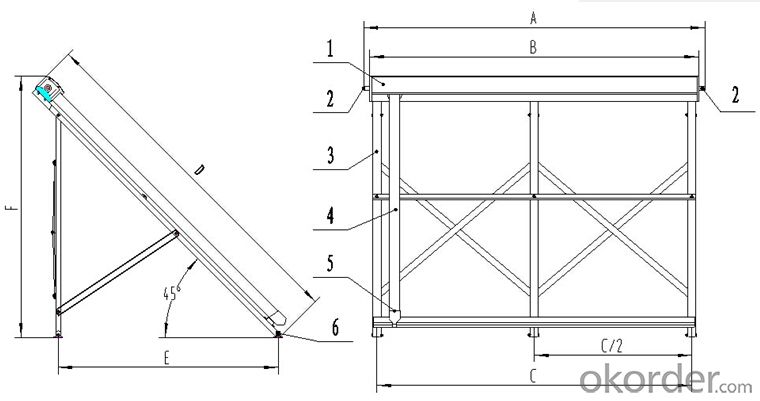
1,Solar collector manifold :
2,Solar collector connector
3,Solar collector bracket
4,All glass vacuum tube:
5,Tube holder
6,Wind feet
2. Main Features of Polyurethane Foaming Insulation Solar Collector Model SC-HP:
The heat insulation properties is higher than for other types of the same collector design
Three layers of insulation incorporated in the mainfold casing :
(1)first and third layer is Aluminium Silicate and resist temperatures of up to 800℃;
(2)second layer is Polyurethane formed by Italian machine that insulates the tanks with a density of 38.5-42;
3. Polyurethane Foaming Insulation Solar Collector Model SC-HP Images:
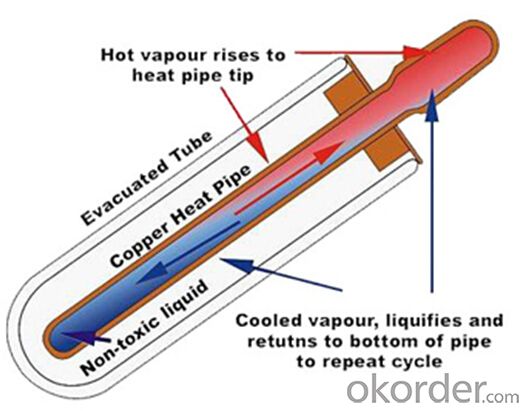
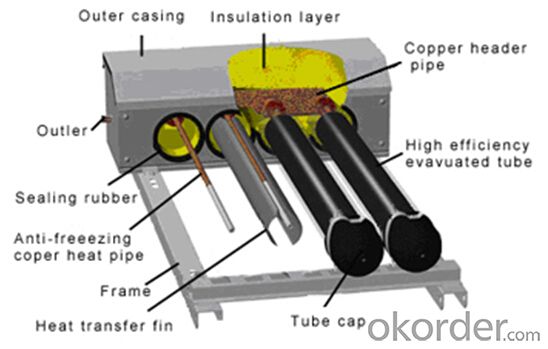
4. Polyurethane Foaming Insulation Solar Collector Model SC-HP Specifications
Model | SC-HP-10 | SC-HP-15 | SC-HP-18 | SC-HP-20 | SC-HP-24 | SC-HP-25 | SC-HP-30 |
SC-H1-10 | SC-H1-15 | SC-H1-18 | SC-H1-20 | SC-H1-24 | SC-H1-25 | SC-H1-30 | |
Vacuum tube quantity(pcs) | 10 | 15 | 18 | 20 | 24 | 25 | 30 |
Tube spacing (㎜) | 75 | 75 | 75 | 75 | 75 | 75 | 75 |
Vacuum tube diameter/length (㎜) | φ58/1700 | φ58/1700 | φ58/1700 | φ58/1700 | φ58/1700 | φ58/1700 | φ58/1700 |
Vacuum tube material | high borosilicate glass 3.3 | high borosilicate glass 3.3 | high borosilicate glass 3.3 | high borosilicate glass 3.3 | high borosilicate glass 3.3 | high borosilicate glass 3.3 | high borosilicate glass 3.3 |
Vacuum tube inner/outer pipe wall thickness (㎜) | 1.6/1.8 | 1.6/1.8 | 1.6/1.8 | 1.6/1.8 | 1.6/1.8 | 1.6/1.8 | 1.6/1.8 |
Heat pipe condensing end diameter/length (㎜) | φ14/1750 | φ14/1750 | φ14/1750 | φ14/1750 | φ14/1750 | φ14/1750 | φ14/1750 |
heat pipe material/wall thickness (㎜) | Copper tp2/0.6 | Copper tp2/0.6 | Copper tp2/0.6 | Copper tp2/0.6 | Copper tp2/0.6 | Copper tp2/0.6 | Copper tp2/0.6 |
inner tank diameter/wall thickness (㎜) | φ35/1.0 | φ35/1.0 | φ35/1.0 | φ35/1.0 | φ35/1.0 | φ35/1.0 | φ35/1.0 |
connector size | φ22 or 3/4″ | φ22or 3/4″ | φ22or 3/4″ | φ22or 3/4″ | φ22or 3/4″ | φ22or 3/4″ | φ22or 3/4″ |
collector insulation material/thickness (㎜) | Polyurethane/40 | Polyurethane/40 | Polyurethane/40 | Polyurethane40 | Polyurethane40 | Polyurethane/40 | Polyurethane/40 |
solar collector rated pressure (MPa) | 0.6 | 0.6 | 0.6 | 0.6 | 0.6 | 0.6 | 0.6 |
collector operating temperature ℃ | <100 | <100 | <100 | <100 | <100 | <100 | <100 |
collector volume (L) | 0.69 | 0.98 | 1.15 | 1.27 | 1.50 | 1.56 | 1.85 |
collector aperture area (㎡) | 1.0 | 1.5 | 1.8 | 2.0 | 2.4 | 2.5 | 3.0 |
collector total area (㎡) | 1.56 | 2.30 | 2.74 | 3.04 | 3.63 | 3.77 | 4.51 |
referral traffic (L/min) | 0.75 | 1.13 | 1.35 | 1.50 | 1.81 | 1.88 | 2.26 |
intensity pressure (Pa) | 23.2 | 59.2 | 90.6 | 116.7 | 181.7 | 200.2 | 314.0 |
intercept efficient η0 | 0.744 | 0.744 | 0.744 | 0.744 | 0.744 | 0.744 | 0.744 |
heat loss coefficient a | 2.09 | 2.09 | 2.09 | 2.09 | 2.09 | 2.09 | 2.09 |
collector power (W)1000W/㎡ irradiation | 620 | 870 | 1047 | 1165 | 1401 | 1457 | 1748 |
collector net weight (kg) | 38.25 | 50.75 | 59.75 | 64.75 | 79.00 | 83.35 | 98.70 |
a (㎜) | 895 | 1270 | 1495 | 1645 | 1945 | 2020 | 1395 |
b (㎜) | 800 | 1175 | 1400 | 1550 | 1850 | 1925 | 2300 |
c (㎜) | 725 | 1100 | 1325 | 1475 | 1775 | 1850 | 2225 |
c/2 (㎜) | —— | —— | —— | —— | 887.5 | 925 | 1112.5 |
d (㎜) | 1980 | 1980 | 1980 | 1980 | 1980 | 1980 | 1980 |
e (㎜) | 1240 | 1240 | 1240 | 1240 | 1240 | 1240 | 1240 |
f (㎜) | 1470 | 1470 | 1470 | 1470 | 1470 | 1470 | 1470 |
5. FAQ
(1) Which collector is the best value for money?
Rather than looking at just peak efficiency levels when comparing solar collectors, cost per unit of energy produced is much more logical. For example: Although collector A may be 20% more efficient than collector B, if collector A is 30% more expensive, then in fact collector B may be a better choice, as per kWh of energy produced per day it is cheaper. When payback time is of concern, not only price per kWh of the product is important, but also of the end system.
(2) Can this solar collectors be used for a large scale hot water production?
Yes. This solar collectors can be connected in series or parallel to provide large scale hot water production for a commercial settings such as a school, hotel or office building. There is really no limit to the size of the system, however collectors must be installed in banks of no more than 150 tubes (in series), otherwise the water may boil.
(3) What maintenance of the solar collector is required?
Under normal circumstances no maintenance of the system is required. Due to the shape of the tubes regular rainfall and wind should keep the tubes clean. Should a tube even be broken it should be replaced. This, however, is an inexpensive and easy job. Any "handy" person can install a new tube (while adhering to local health and safety regulations). Sidite solar collectors can operate with several broken tubes, however the efficiency will be reduced slightly.
- Q: How do solar collectors perform in areas with air pollution?
- Solar collectors can be affected by air pollution in areas with high levels of pollutants. The presence of pollutants like smog, dust, and other particulate matter can reduce the efficiency of solar collectors by blocking sunlight and reducing the amount of energy they can capture. Regular cleaning and maintenance of the collectors can help mitigate the impact of air pollution on their performance. Additionally, advancements in technology and design are being made to develop more robust solar collectors that can better withstand and adapt to polluted environments.
- Q: Can solar collectors be used for heating water for educational institutions?
- Yes, solar collectors can definitely be used for heating water in educational institutions. Solar water heaters are a sustainable and cost-effective solution for meeting the hot water demands of schools, colleges, and universities. These institutions often have a high requirement for hot water due to the presence of numerous students and faculty members. Solar collectors, also known as solar thermal panels, capture energy from the sun and convert it into heat. This heat can then be used to warm water for various purposes, such as showers, kitchen use, and heating systems. By utilizing solar collectors, educational institutions can significantly reduce their reliance on traditional energy sources like electricity or gas, thereby decreasing their carbon footprint and contributing to a greener environment. The installation of solar water heating systems can provide numerous benefits for educational institutions. Firstly, it allows them to save on their energy bills as the sun's energy is free. This cost savings can be redirected towards other educational programs or facility improvements. Additionally, utilizing solar energy aligns with the educational institutions' commitment to sustainability and can serve as an educational tool for students to learn about renewable energy and environmental conservation. Solar water heating systems are versatile and can be designed to meet the specific hot water demands of educational institutions. The size and number of solar collectors can be customized based on the institution's requirements, ensuring an adequate supply of hot water throughout the year. Furthermore, solar water heating systems are reliable and require minimal maintenance. With proper installation and routine check-ups, these systems can have a long lifespan, ensuring a consistent supply of hot water for educational institutions for many years. In conclusion, solar collectors are an excellent choice for heating water in educational institutions. They offer cost savings, contribute to sustainability efforts, and provide educational opportunities for students. By harnessing the power of the sun, educational institutions can meet their hot water demands while reducing their environmental impact.
- Q: Can solar collectors be used for heating radiant floor systems?
- Yes, solar collectors can be used for heating radiant floor systems. Solar thermal energy can be captured by the collectors and transferred to a fluid, which then circulates through the radiant floor system to provide heating. This allows for efficient and environmentally friendly heating of the space.
- Q: How long does it take for a solar collector system to pay for itself?
- The payback period for a solar collector system can vary based on several factors including the initial cost, energy savings, and local incentives. On average, it takes around 5 to 10 years for a solar collector system to pay for itself through reduced energy bills.
- Q: How much energy can a solar collector produce?
- The amount of energy a solar collector can produce varies depending on several factors such as the size and efficiency of the collector, the amount of sunlight available, and the location. On average, a solar collector can generate anywhere from 100 to 400 watts per square meter of collector area. However, with advancements in technology and larger installations, it is possible to achieve even higher energy production.
- Q: Can solar collectors be used to generate hot water for industrial processes?
- Yes, solar collectors can be used to generate hot water for industrial processes. Solar thermal systems can efficiently capture the sun's energy to heat water, which can then be used for various industrial applications such as cleaning, sterilization, and heating. This renewable and sustainable method significantly reduces the reliance on fossil fuels and helps industries adopt cleaner energy sources.
- Q: Can solar collectors be used for generating electricity on shopping malls?
- Yes, solar collectors can be used for generating electricity on shopping malls. Solar collectors, such as photovoltaic panels, can be installed on the rooftops or facades of shopping malls to convert sunlight into electricity. This renewable energy source can help reduce the malls' reliance on traditional energy sources and lower their carbon footprint. Additionally, solar collectors can provide a sustainable and reliable source of electricity, especially during peak energy demand periods. Shopping malls often have large surface areas, making them suitable locations for solar installations. With the advancements in solar technology and decreasing costs, more and more shopping malls are adopting solar collectors to generate clean and green electricity.
- Q: Can solar collectors be used for swimming pool heating?
- Yes, solar collectors can be used for swimming pool heating. Solar collectors, such as solar panels or solar thermal systems, can harness the sun's energy to heat water that is then circulated through the pool, providing a cost-effective and sustainable solution for pool heating.
- Q: Can solar collectors be used in smart grid systems?
- Yes, solar collectors can be used in smart grid systems. Solar collectors can generate clean and renewable energy, which can be integrated into smart grid systems for efficient distribution and management of electricity. This integration allows for better monitoring and control of solar energy production and consumption, optimizing the overall performance and reliability of the smart grid system.
- Q: Are solar collectors suitable for high-rise buildings?
- Yes, solar collectors are suitable for high-rise buildings. With advancements in technology, solar collectors can be installed on rooftops or integrated into building facades, allowing high-rise buildings to harness solar energy efficiently. This helps reduce dependence on traditional energy sources, lowers energy costs, and promotes sustainability in urban environments.
Send your message to us
Apricus Evacuated Tube Solar Collectors - Polyurethane Foaming Insulation Model SC-HP
- Loading Port:
- Shanghai
- Payment Terms:
- TT OR LC
- Min Order Qty:
- 50 set
- Supply Capability:
- 200 set/month
OKorder Service Pledge
OKorder Financial Service
Similar products
Hot products
Hot Searches
Related keywords




